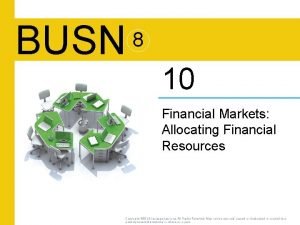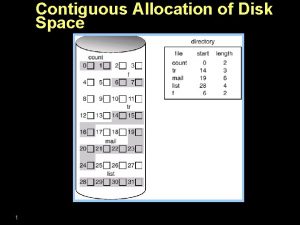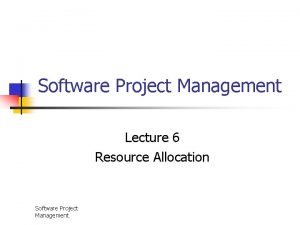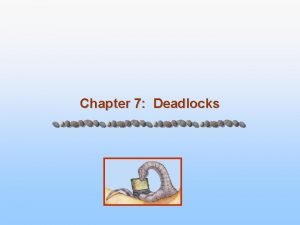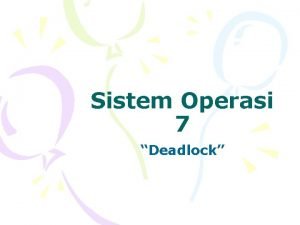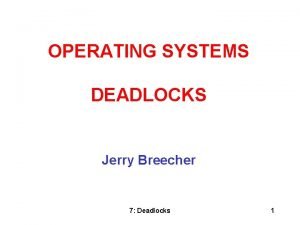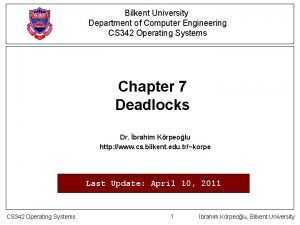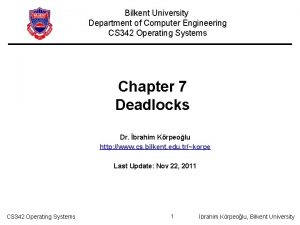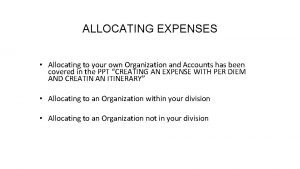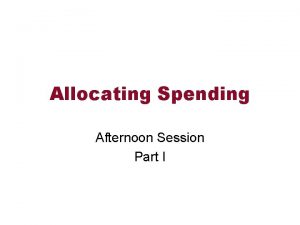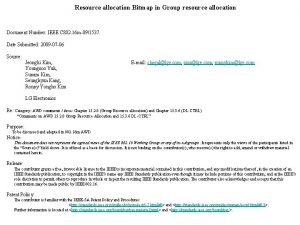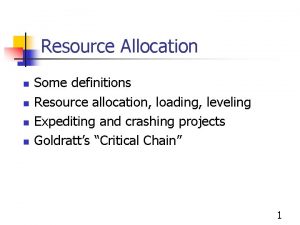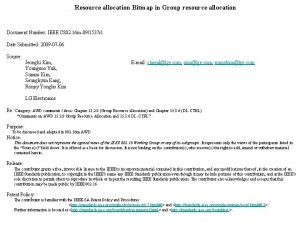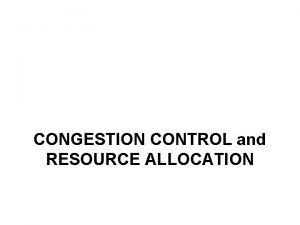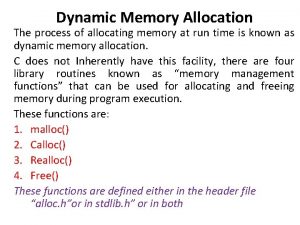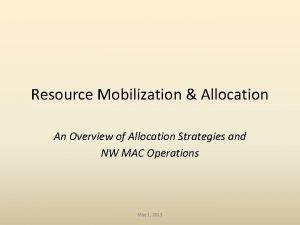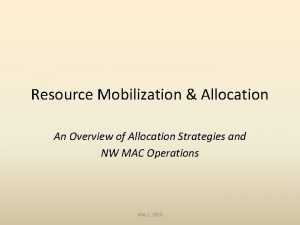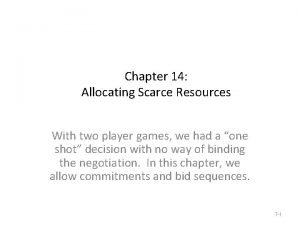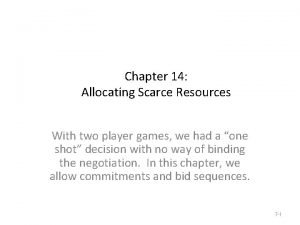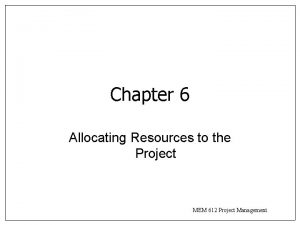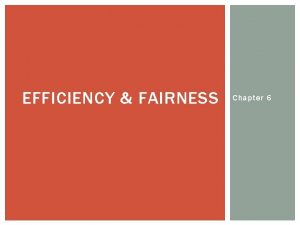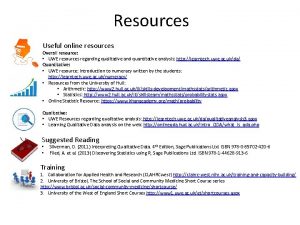Chapter 8 Resource Allocation Allocating Resources to the



























































- Slides: 59

Chapter 8 Resource Allocation

Allocating Resources to the Project • Allocation of physical resources to one or multiple projects. • At any given time, the firm may have fixed level of various resources like - labor-hours of various types of professionals - machine hours of various types of machinery - hours of computing time - specialized locations • The project schedule should be adjusted to smooth the use of the resources

Crashing a Project • Time and cost are interrelated • The faster an activity is completed, the more it costs • Change the schedule and you change the budget • Thus many activities can be speeded up by spending more money

What is Crashing / Crunching? • To speed up, or expedite, a project • Of course, the resources to do this must be available • Crunching a project changes the schedule for all activities • This will have an impact on schedules for all the subcontractors • Crunching a project often introduces unanticipated problems

Crashing an activity refers to the speeding up or shortening of the duration of an activity by using additional resources. These include overtime, hiring temporary staff, renting more efficient equipment, and other measures. Project crashing refers to the process of shortening the duration of the project by crashing the duration of a number of activities. Since it generally results in an increase of the overall project costs, the challenge faced by the project manager is to identify the activities to crash and the duration reduction for each activity such that as the project crashing is done in the least expensive manner possible.

Direct Cost vs. Indirect Cost • Direct cost increases if the activity duration is to be reduced. • The Indirect cost decreases if the activity duration is to be reduced.

Activity Cost Slope

An Example of Two-Time CPM

Activity Slopes—Cost per Period for Crashing Negative slope: as the time required for a project or task is decreased, the cost is increased.

Crashing the Project Figure 9 -1 a

Seven Day Schedule Figure 9 -1 b

Six Day Schedule Figure 9 -1 c

Five Day Schedule Figure 9 -1 d

Four Day Schedule Figure 9 -1 e

Cost-Crash Curve Figure 9 -2

Crashing the Project When crashing a project, first task is to develop a table or graph of the cost of a project as a function of the project’s various possible completion dates. Crash selected activities, one at a time, to decrease the project duration.

Crashing the Project Two principles: • Focus on the critical path(s) when trying to shorten the duration of a project. (Crashing a non-critical activity will not influence project duration. ) • When shortening a project’s duration, select the least expensive way to do it.

Question 1 (Crashing example) Direct Cost – Rs. 25, 500 Indirect Cost – Rs. 200/day ] 3 , 5 1 [ A 50 C[ 8 120 , 7] D [10, 8] 10 2 B [25, 15] 100 3 E[ 2 75 2, 19] 4 ] 7, 5 [ F 90 5 0 H [10, 8] 250 G[ 6, 6 ] 6 The above figure gives data on normal time and cost and crash time and cost for a project. (a) What is the normal project duration and associated cost? (g) Crash the relevant activities systematically and determine the optimum project time and crashing cost.

Step 1. Identify critical path Path Normal AEH BH CFH ADG 37 (Critical Path) 35 25 21 Crashing A by 2 days 35 35 25 19 Step 2. Rank activity on critical path according to crash costs. A – 50 (Lowest) can be crashed by 2 days E – 75 H – 250

Step 3: Now there are 2 critical paths : AEH & BH Rank activity on critical paths according to crash costs. A – 50 (can’t be crashed) B-100 E – 75 H-250 H – 250 Activities B & E (100+75) can be crashed by 3 days.

Path Normal Crashing E, B A by 2 day by 3 days AEH 37 35 32 BH 35 35 32 CFH 25 25 25 ADG 21 19 19 Step 4: Again there are 2 critical paths : AEH & BH Rank activity on critical paths according to crash costs. A – 50 (can’t be crashed) B-100 E – 75 (can’t be crashed) H-250 H – 250 Activities H (250) can be crashed by 2 days.

Step 5 Path Normal Crashing A by 2 day E, B by 3 days Crashing H by 2 days AEH BH 37 35 35 35 32 32 30 30 CFH ADG 25 21 25 19 23 19 Step 6: Again there are 2 critical paths : AEH & BH Rank activity on critical paths according to crash costs. A – 50 (can’t be crashed) B-100 E – 75 (can’t be crashed) H-250 H – 250 (can’t be crashed) No further crashing is possible.

Crashing table Project Length Cumulative Direct costs weeks crashing shortened costs Indirect costs Total costs 37 0 0 25500 37 X 200 =7400 32900 36 1 50 25500 36 X 200 =7200 32750 35 2 50+50=100 25500 35 X 200 =7000 32600 34 3 100+175=275 25500 34 X 200 = 6800 32575 33 4 275+175=450 25500 33 X 200 =6600 32550 32 5 450+175= 625 25500 32 X 200 =6400 32525 31 6 625+250= 875 25500 31 X 200 =6200 32575 30 7 875+250 = 1125 25500 30 X 200 =6000 32625 Remarks Normal duration Optimum duration Minimum duration

Question 2 The normal time, crash time and crashing cost per day are given for the following network: Activity Event A B C D E F 1 -2 1 -3 2 -4 3 -4 4 -5 Normal Time (Days) 18 23 8 10 3 8 Crash Time (Days) 14 22 5 6 2 6 Crashing Cost (Rs. /day) 40 20 60 40 80 50 (i) Find AOA network. (ii) Crash the project duration in steps and arrive at the minimum duration. What will be the min. duration and the cost of crashing? (iii) If there is a direct cost of Rs. 10, 000 & an indirect cost of Rs. 70 per day, what will be the optimal project duration and associated cost of crashing?

Solution Q 2 (Crashing example) Direct Cost – Rs. 10, 000 Indirect Cost – Rs. 70/day 2 A 1 18 B 23 D 10 C 8 E 3 Paths: 1. ACEF -37 Days 2. BEF -34 Days 3. ADF -36 Days 3 4 F 8 5

Step 1. Identify critical path Path Normal ACEF ADF BEF 37 (Critical Path) 36 34 Crashing A by 3 days 34 33 34 Step 2. Rank activity on critical path according to crash costs. A – 40 (Lowest) can be crashed by 3 days C – 60 E – 80 F – 50

Step 3: Now there are 2 critical paths : ACEF & BEF. Rank activity on critical paths according to crash costs. A – 40 B – 20 C – 60 E – 80 F – 50 Activity F (50) can be crashed by 2 days.

Path Normal Crashing A Crashing F by by 3 days 2 days ACEF ADF BEF 37 36 34 34 33 34 32 31 32 Step 4: Again there are 2 critical paths : ACEF & BEF Rank activity on critical paths according to crash costs. A – 40 B – 20 C – 60 E – 80 F – 50 (can’t be crashed) Activities A+ B (40+20) can be crashed by 1 day.

Path Step 5 Norm Crashing al A by 3 F by 2 days Crashing A&B by 1 day ACEF 37 34 32 31 ADF 36 33 31 30 BEF 34 34 32 31 Step 6: Again there are 2 critical paths : ACEF & BEF Rank activity on critical paths according to crash costs. A – 40 (can’t be crashed) B – 20 (can’t be crashed) C – 60 E – 80 F – 50 (can’t be crashed) Activities E(80) can be crashed by 1 day.

Step 7 Path Norm Crashing A al by 3 days Crashing F by 2 days Crashing A&B by 1 day Crashing E by 1 day ACEF 37 ADF 36 34 33 32 31 31 30 30 30 BEF 34 32 31 30 34 Step 8: Now there are 3 critical paths : ACEF, ADF & BEF. Rank activity on critical paths according to crash costs. A – 40 (can’t be crashed) B – 20 (can’t be crashed) A – 20 (can’t be crashed) C – 60 E – 80 (can’t be crashed) D – 20 E – 80 (can’t be crashed) F – 50 (can’t be crashed) F – 20 (can’t be crashed) F – 50 (can’t be crashed) No further crashing is possible.

Crashing table Project Length Cumulative weeks shortened Cumulative crashing costs Direct costs Indirect costs Total costs Remarks 37 0 0 10000 37 X 70 =2590 12590 36 1 40 10000 36 X 70 =2520 12560 35 2 40+40=80 10000 35 X 70 =2450 12530 34 3 80+40=120 10000 34 X 70 = 2380 12500 33 4 120+50=170 10000 33 X 70 =2310 12480 32 5 170+50= 220 10000 32 X 70 =2240 12460 31 6 220+60= 280 10000 31 X 70 =2170 12450 Optimum duration 30 7 280+80 = 360 10000 30 X 70 =2100 12460 Minimum duration Normal duration

Solution Q 2 (Crashing example) Ans. : (ii) Min. Duration is 30 days & total cost is Rs. 12460. (iii) Optimum Duration is 31 days & total cost is Rs. 12450.

Question 3 The above figure gives data on normal time and cost and crash time and cost for a project. Crash the relevant activities systematically and determine the optimum project time and crashing cost. 3 E [8 ] 1 7 , 20 , 6] [8 D 0 10 H [2, 1] G [5, 3] F [10, 5] A [9, 6] 6 7 4 1 210 2 300 180 50 ] 9 , B 0 1 [ [ 50 9, 5 C 0 ] 8 1 5 • Direct Cost – Rs. 37, 500 Indirect Cost – Rs. 250/day

Crashing table Project Length Cumulative Direct costs weeks crashing shortened costs Indirect costs Total costs 30 0 0 37500 30 X 250 45000 29 1 50 37500 29 X 250 44800 28 2 50+50=100 37500 28 X 250 44600 27 3 100+50=150 37500 27 X 250 44400 26 4 150+50+100= 300 37500 26 X 250 44300 25 5 300+210= 510 37500 25 X 250 44260 24 6 510+210= 720 37500 24 X 250 44220 23 7 720+210 = 930 37500 23 X 250 44180 22 8 930+300 = 1230 37500 22 X 250 44230 21 9 1230+ 300= 1580 37500 21 X 250 44330 Remarks Normal duration Optimum duration Minimum duration

Question 4: Indirect cost: Rs. 100/day Events Normal Crash Activity Time (days) Cost (Rs) 1 -2 3 360 2 400 2 -3 6 1440 4 1620 2 -4 9 2160 5 2380 2 -5 7 1120 5 1600 3 -4 8 400 4 800 4 -5 5 1600 3 1770 5 -6 3 480 2 760 The above table gives data on normal time and cost and crash time and cost for a project. (a) What is the normal project duration and associated cost? (g) Crash the relevant activities systematically and determine the optimum project time and crashing cost.

Risks in Project Crashing Various external and internal factors may lead project manager to go for crashing, but it usually affects the quality of work as the time taken (besides cost) is the major issue on his mind: • New resources aren't going to be familiar with the tasks at hand, so they will probably be less productive than current team members. • Who will guide the new members up the learning curve? Usually it will be the most productive members of the team, who could themselves be working to get the task finished more quickly. • Being available does not equal being qualified. For example, while outsourcing, one can't be sure that workers are trained enough to deliver as per expected standards.

Project Fast Tracking • Fast tracking means that the activities that are normally done in sequence are instead performed partially in parallel. In other words, Fast tracking is applied by rescheduling various activities within the project to be worked on simultaneously instead of waiting for each piece to be completed separately. • Fast-tracking always involves risk that could lead to increased cost and some rework later. • A good rule of thumb is that sequential activities can sometimes be fast-tracked by up to 33%. In other words, if you're fast-tracking, you can start the second of two sequential activities when the first activity is 66% complete.

The Resource Allocation Problem • As discussed, CPM/PERT ignore resource utilization and availability • Critical resources can’t be renewed or inventoried. • Schedules need to be evaluated in terms of both time and resources (scarce ones) • Time Limited vs. Resource Limited

Resource Loading • Resource loading describes the amount of resources an existing schedule requires • Gives an understanding of the demands a project will make of a firm’s resources

Resource A

Resource B

Resource Leveling • Approach to even out the peaks and valleys of resource requirements so that a fixed amount of resources can be employed over time. • Less hands-on management is required • May be able to use just-in-time inventory • Improves morale • Fewer personnel problems

Resource Leveling Continued • When an activity has slack, we can move that activity to shift its resource usage • May also be possible to alter the sequence of activities to levelize resources • Small projects can be levelized by hand • Software can levelize resources for larger projects • Large projects with multiple resources are very complex to levelize

Resource Leveling Steps ØCreate a project activity network diagram and mention the duration of the activities ØCalculate EOT (Earliest occurrence time) for all the events. This helps in calculation of float/ slack of activities ØDevelop a time-phased resource loading diagram ØIdentify any resource conflicts and begin to smooth the loading table using slacks

Resource Leveling Techniques 1. Shift the start date of an activity within its slack time 2. Split the activity within its slack time

Resource Leveling Example: Activity Duration Manpower Req. 1 -2 6 8 1 -3 10 4 1 -4 6 9 2 -3 10 7 2 -4 4 6 3 -5 6 17 4 -5 6 6 Q: Reduce the peak manpower requirement and smoothen the period to period resource requirement.

Solution

Question: • A job requires the following resources: • Scenario 1: Six crane operators have been recruited for the job. How would you manage the job so as to complete it at the earliest? • Scenario 2: Six crane operators have been recruited for the job, but one would join on the 7 th day. How would you manage the job so as to complete it at the earliest?

Solution – Scenario 2 • Resource loading diagram

Solution contd… • Levelled

Constrained Resource Scheduling Heuristic Approach An approach, such as a rule of thumb, that yields a good solution that may or may not be optimal. Optimization Approach An approach, such as linear programming, that yields the one best solution.

Heuristic Methods The only feasible way on large projects While not optimal, the schedules are very good Take the CPM/PERT schedule as a baseline They sequentially step through the schedule trying to move resource requirements around to levelize them • Resources are moved around based on one or more priority rules • •

Common Priority Rules • • As soon as possible As late as possible Shortest task first Most resources first Minimum slack first Most critical followers Most successors Arbitrary

Heuristic Methods Continued • These are just the common ones • There are many more • The heuristic can either start at the beginning and work forwards • Or it can start at the end and work backwards

Optimization Methods • Finds the one best solution • Uses either linear programming or enumeration • Not all projects can be optimized • Approaches only work with small to medium projects

Standards to Measure Schedule Effectiveness 1. Schedule slippage 2. Resource utilization 3. In-process inventory

Schedule Slippage • The time past a project’s due date when the project is completed • Slippage may cause penalties • Different projects will have different penalties • Expediting one project can cause others to slip • Taking on a new project can cause existing projects to slip

Resource Utilization • The percentage of a resource that is actually used • We want a schedule that smoothes out the dips and peaks of resource utilization • This is especially true of labor, where hiring and firing is expensive

In-Process Inventory • This is the amount of work waiting to be processed because there is a shortage of some resource • Similar to WIP in manufacturing • The cost here is holding cost
 Markets allocating resources
Markets allocating resources Resource leveling is the approach to even out the peaks of
Resource leveling is the approach to even out the peaks of Contiguous allocation vs linked allocation
Contiguous allocation vs linked allocation A free map determines which blocks are free, allocated.
A free map determines which blocks are free, allocated. Namei algorithm
Namei algorithm Resource requirements example
Resource requirements example Algoritmo del banchiere
Algoritmo del banchiere Resource histogram
Resource histogram Resource allocation graph and wait for graph
Resource allocation graph and wait for graph Resource allocation graph
Resource allocation graph Deadlock sistem operasi
Deadlock sistem operasi Resource allocation graph
Resource allocation graph Distributed resource allocation
Distributed resource allocation The plan of action that prescribes resource allocation
The plan of action that prescribes resource allocation Ooqqq
Ooqqq Cs 433 bilkent
Cs 433 bilkent Resource allocation graph in os
Resource allocation graph in os Resources allocation and mobilization plan (ramp)
Resources allocation and mobilization plan (ramp) Perbedaan resource loading dan resource leveling
Perbedaan resource loading dan resource leveling What is the transformation process
What is the transformation process Fixed resources and variable resources
Fixed resources and variable resources Renewable vs nonrenewable resources worksheet
Renewable vs nonrenewable resources worksheet Hình ảnh bộ gõ cơ thể búng tay
Hình ảnh bộ gõ cơ thể búng tay Ng-html
Ng-html Bổ thể
Bổ thể Tỉ lệ cơ thể trẻ em
Tỉ lệ cơ thể trẻ em Gấu đi như thế nào
Gấu đi như thế nào Tư thế worms-breton
Tư thế worms-breton Bài hát chúa yêu trần thế alleluia
Bài hát chúa yêu trần thế alleluia Môn thể thao bắt đầu bằng chữ đua
Môn thể thao bắt đầu bằng chữ đua Thế nào là hệ số cao nhất
Thế nào là hệ số cao nhất Các châu lục và đại dương trên thế giới
Các châu lục và đại dương trên thế giới Công thức tính thế năng
Công thức tính thế năng Trời xanh đây là của chúng ta thể thơ
Trời xanh đây là của chúng ta thể thơ Mật thư anh em như thể tay chân
Mật thư anh em như thể tay chân 101012 bằng
101012 bằng Phản ứng thế ankan
Phản ứng thế ankan Các châu lục và đại dương trên thế giới
Các châu lục và đại dương trên thế giới Thể thơ truyền thống
Thể thơ truyền thống Quá trình desamine hóa có thể tạo ra
Quá trình desamine hóa có thể tạo ra Một số thể thơ truyền thống
Một số thể thơ truyền thống Bàn tay mà dây bẩn
Bàn tay mà dây bẩn Vẽ hình chiếu vuông góc của vật thể sau
Vẽ hình chiếu vuông góc của vật thể sau Biện pháp chống mỏi cơ
Biện pháp chống mỏi cơ đặc điểm cơ thể của người tối cổ
đặc điểm cơ thể của người tối cổ Thế nào là giọng cùng tên?
Thế nào là giọng cùng tên? Vẽ hình chiếu đứng bằng cạnh của vật thể
Vẽ hình chiếu đứng bằng cạnh của vật thể Vẽ hình chiếu vuông góc của vật thể sau
Vẽ hình chiếu vuông góc của vật thể sau Thẻ vin
Thẻ vin đại từ thay thế
đại từ thay thế điện thế nghỉ
điện thế nghỉ Tư thế ngồi viết
Tư thế ngồi viết Diễn thế sinh thái là
Diễn thế sinh thái là Dot
Dot Các số nguyên tố là gì
Các số nguyên tố là gì Tư thế ngồi viết
Tư thế ngồi viết Lời thề hippocrates
Lời thề hippocrates Thiếu nhi thế giới liên hoan
Thiếu nhi thế giới liên hoan ưu thế lai là gì
ưu thế lai là gì Hổ đẻ mỗi lứa mấy con
Hổ đẻ mỗi lứa mấy con
